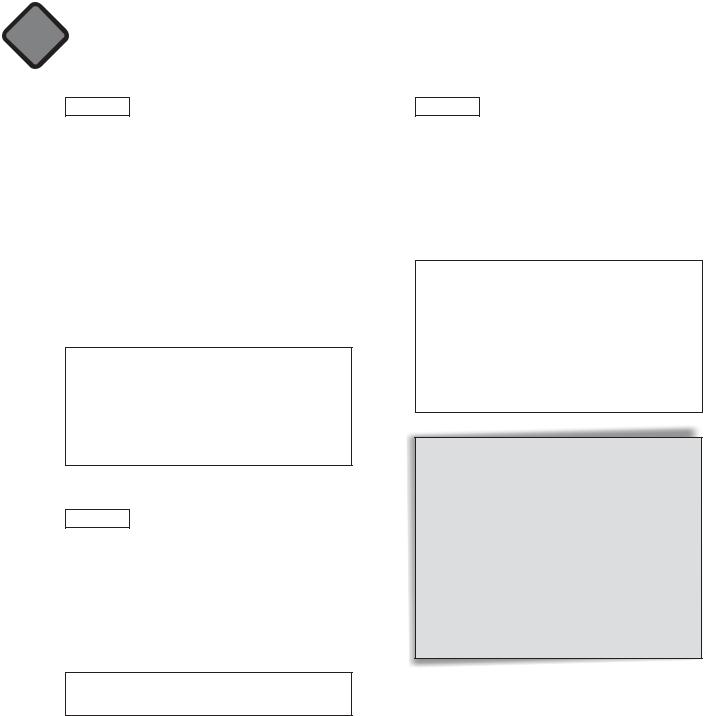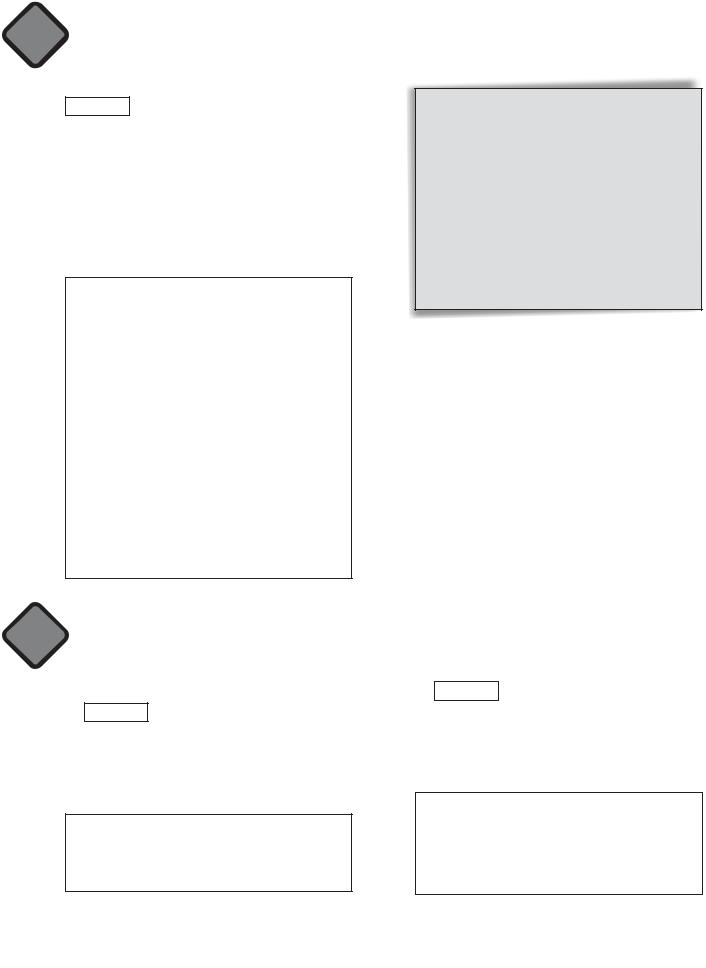
Sportlight_7
.pdf
c) Focus Practising relative pronouns or
adverbs
Ss work in pairs. Read the rubric and explain the task. Allow time for Ss to prepare and then select some pairs to act out their exchange for the class.
Suggested Answer Key
A:doctor
B:A doctor is someone who treats sick people.
A:bank
B:That’s the bank where your mum works. etc
Speaking
6Focus
ñ
ñSs and
Suggested Answer Key
S1: I love painting.
S2: Why do you like painting?
S1: I like painting because I like creating things. S3: What kind of things do you paint?
S1: I like painting animals. etc
Writing
7Focus An e-mail to a pen-friend about a
teenager you find interesting
Go through the rubric with Ss and elicit key words (which teenagers, interesting, e-mail, pen-friend). Elicit from Ss what they need to write. Brainstorm ideas and write them on the board. Allow Ss time to complete the task in class. Check Ss’ work and give feedback. Alternatively, you can assign the task for HW provided you have gone through it orally in class.
Lead the way! 3a
Suggested Answer Key
Hi Samantha,
Thanks for your e-mail. I’m glad you are well.
Do you know who Chase Austin is? He is an American teenager who I find really interesting.
His hobby is car racing and he drove in his first race when he was only 8 years old.
I like him because he is not afraid to work hard to get what he wants.
Write soon and tell me about someone who you admire.
Love,
James
Synergy
ñAllow Ss one minute to think of ten words they have learnt in today’s lesson. Ask Ss to use them to make their own sentences.
ñWhen Ss have finished ask them to get up and go around the class to find a partner who has something in common with them e.g. same hair/eye colour, same clothes, same taste in music, etc.
ñAsk Ss to discuss what they have learnt in the lesson with their partner.
41

3 b Who’s who?
Objectives
Vocabulary: building vocabulary related to physical appearance
Reading & Listening: a dialogue about people’s appearance
Grammar: -ed/-ing participles; order of adjectives Everyday English: describing appearance Listening: multiple choice questions
Writing: a letter to a pen friend about a neighbour
Introduction
Ask Ss to look at the title, Who’s who?, and the pictures. Elicit/Explain the meaning of the title (determining who someone is). Ask them what they think the unit will be about. Encourage Ss to predict what vocabulary they will see in the unit.
Vocabulary
1Focus Building vocabulary related to
appearance
Focus Ss’ attention on the title of the unit and the drawings of the characters. Ask Ss if they know of any of these characters and which books they are from. Stimulate discussion about the characters. Elicit adjectives of description from Ss. Ask the Ss to listen and check. Play recording. Ss listen and check.
Suggested Answer Key
Alice ― Alice in Wonderland
The Duchess ― Alice in Wonderland Scrooge ― A Christmas Carol
Bob Cratchit ― A Christmas Carol Dorothy ― The Wonderful Wizard of Oz
Wicked Witch ― The Wonderful Wizard of Oz Peter Pan ― Peter Pan
Captain Hook ― Peter Pan
2 a) Focus Building vocabulary related to
appearance
Ask Ss to look at the table of adjectives. Select Ss to read the words aloud. Elicit/Explain any unknown words. Ask Ss to underline the words
they heard in the recording. Play recording again. Ss complete the task. Ss compare answers. Check answers.
Answer Key
young, cute, freckles, long, brown, pigtails, old, ugly, thin, short, blond, skinny, elderly, grey, bald, red, tall, dark, curly, shoulderlength, middle-aged, tan, beard, scar, slim, pretty, straight, big, fat, round
Game
b) Focus Describing a character
Ss play in teams. One team chooses a character and the other team asks questions to find out who the character is. When they have guessed correctly, it is their turn to pick a character.
Suggested Answer Key
Team A S1: Is it a man or a woman?
Team B S1: It’s a man.
Team A S2: Is he tall?
Team B S2: Yes, he is.
Team A S3: Has he got dark hair?
Team B S3: No, he hasn’t.
Team A S4: Has he got red hair?
Team B S4: Yes.
Team A S5: Is it Bob Cratchit?
Team B S5: Yes, it is.
Reading & Listening
3 a) Focus Reading for gist/specific information
Ask Ss to read the first exchange in the dialogue and to try to guess where the speakers are. Ss listen to/read the dialogue and check their answers.
Answer Key
They are at a party.
Alice and the Duchess were in the play.
42

Who’s who? 3b
b)Focus Reading for specific information
ñAsk Ss to read the questions so they know what information they are looking for. Then ask Ss to read the dialogue. Allow Ss time to complete the task individually. Go around the classroom monitoring Ss’ work and helping with any difficulties. When Ss have completed the task ask Ss to compare their answers with a partner. Check answers with the class. Write answers on board.
describe how we feel about something are excited.
ñElicit other examples from the class. Ask Ss to open their books and read the theory box silently. Check Ss’ understanding and help with any difficulties if necessary.
ñGo through sentences 1-5 with Ss, explaining/ eliciting any unknown words. Explain the task. Allow time for Ss to perform the task. Ss compare answers. Check answers with the class.
|
|
|
|
|
|
|
|
|
Answer Key |
|
|
|
|
|
|
|
|||
Answer Key |
|
|
|
|
|
|
|
|
|
|
|
|
|
|
|||||
|
|
|
|
|
|
|
1 |
scared |
3 |
interested 5 |
disappointed |
|
|||||||
1 F |
2 T |
3 F |
4 F |
5 T |
|
|
|
|
|
||||||||||
|
|
|
2 |
boring |
4 |
tiring |
|
|
|
|
|||||||||
|
|
|
|
|
|
|
|
|
|
|
|
|
|||||||
ñ Ask Ss to explain the meaning of the words in |
|
|
|
|
|
|
|
|
|
|
|
|
|
||||||
|
|
|
|
|
|
|
|
|
|
|
|
|
|||||||
5 |
|
Focus |
Order of adjectives |
|
|
|
|||||||||||||
bold without the use of a dictionary, i.e. they |
|
|
|
|
|||||||||||||||
|
ñ Work with books closed. Draw the following |
||||||||||||||||||
can use synonyms, paraphrase etc. Ask Ss to |
|
||||||||||||||||||
mime or draw their meaning. Elicit/Explain |
|
|
|
table on the board. |
|
|
|
|
|||||||||||
the meanings and write them on the board. Ss |
|
|
|
|
|
|
|
|
|
|
|
|
|
||||||
should copy the words into the vocabulary |
|
|
|
opinion |
|
height/age |
|
origin |
|
noun |
|
||||||||
section of their notebooks. |
|
|
|
|
|
|
|
|
|
|
|
|
|
|
|
|
|
||
|
|
|
|
|
|
nice |
|
young |
|
|
English |
|
man |
|
|||||
|
|
|
|
|
|
|
|
|
|
|
|
|
|
||||||
|
|
|
|
|
|
|
|
|
|
|
|
|
|
|
|
|
|
|
|
|
|
|
|
|
|
|
|
|
|
|
|
|
|
|
|
|
|
|
|
Answer Key |
|
|
|
|
|
|
|
|
|
|
|
|
|
|
|
|
|
|
|
|
|
|
|
|
|
|
|
|
|
|
|
|
|
|
|
|
|
||
exciting (adj): sth which makes you happy and |
|
|
|
|
|
|
|
|
|
|
|
|
|
|
|||||
enthusiastic |
|
|
|
|
|
|
|
|
|
|
|
|
|
|
|
|
|
|
|
stage (n): part of theatre on which actors |
|
|
ñ Explain the adjective order used when |
||||||||||||||||
perform |
|
|
|
|
|
|
|
|
|
describing people. Elicit more examples from |
|||||||||
can’t tell (exp): don’t know |
|
|
|
|
|
|
|
the class and fill in the table. |
|
|
|
||||||||
blond (adj): pale to white colour |
|
|
|
|
ñ Ss open their books and read the theory box. |
||||||||||||||
part (n): role |
|
|
|
|
|
|
|
|
Check Ss’ understanding. Read the rubric and |
||||||||||
cute (adj): nice looking |
|
|
|
|
|
|
|
explain the task. Allow Ss time to complete the |
|||||||||||
introduce (v): meet and tell sb your name |
|
|
|
|
task. Ss compare answers. Check answers with |
||||||||||||||
|
|
|
|
|
|
|
|
|
|
the class. |
|
|
|
|
|
|
|
||
|
|
|
|
|
|
|
|
|
|
|
|
|
|
|
|
|
|||
c)Ss work in pairs. Ask Ss to choose to be Clara or Fiona and to read out the dialogue. Check Ss’ pronunciation.
(Answer as dialogue)
Grammar
4Focus -ed/-ing participles
ñWork with books closed. Write the following sentences on the board.
It is an exciting class. We’re excited!
Explain to Ss that we use the present participle –ing to describe something eg. the class is exciting, and we use the past participle –ed to
Answer Key
1 Mr Brown is a kind elderly French teacher.
2 Sandy is a patient middle-aged British colleague.
3Boris Schwartz is a tall young German tennis player.
43

3b Who’s who?
English
Describing people
ñFocus Ss’ attention on the phrases in the box. Read through the phrases with Ss and explain their use. Elicit/Explain that look like is used to talk about appearance and be like is used for character. Check Ss’ understanding. Read the rubric and explain the task. Go through the example with the class.
ñIn pairs, Ss ask and answer questions about family, friends, teachers etc. Go around the class monitoring Ss’ work and helping with any difficulties. Ask several pairs to act out their dialogues for the class. Give feedback.
Suggested Answer Key
A:What does your mum look like?
B:She’s a tall middle-aged woman with long brown hair.
A:What’s she like?
B:She’s kind and polite … etc.
Listening
7Focus Listening for specific information ―
multiple choice
Read the rubric and explain the task. Ask Ss to read the questions and look at the pictures carefully before they begin so they know what information they are looking for. Play recording twice if necessary. Ss complete the task. Ss compare answers. Check answers with the class.
Answer Key |
|
|
1 C |
2 B |
3 B |
Writing
8Focus A paragraph about your favourite
book character
Go through the rubric with Ss and elicit key words (paragraph, about favourite book character, special about him/her, name, appearance, character). Write the key words on the board. Brainstorm ideas. Allow Ss time to complete task. Have individual Ss read out their paragraphs.
Answer Key
My favourite book character is Man Friday from Daniel Defoe’s Robinson Crusoe. Robinson Crusoe meets him when he is shipwrecked on an island and names him Friday. Friday is a kind and generous Indian with dark skin and long black hair. I like him because he is curious and knows how to do a lot of things.
Synergy
ñAllow Ss one minute to think of ten adjectives they have learnt in today’s lesson. Ask Ss to use them to make their own sentences.
ñWhen Ss have finished ask them to get up and go around the class to find a partner who has something in common with them e.g. same hair/eye colour, same clothes, same taste in music.
ñAsk Ss to discuss what they have learnt in the lesson with their partner.
44

3 c Against all odds
Objectives
Reading: an article describing a person you admire Writing: an article about a person you admire
Introduction
Draw Ss’ attention to the title, Against all odds, and ask them what they think it means. Ask them if they admire anybody and, if so, why. Encourage Ss to predict what vocabulary they will see in the unit.
Reading
3 a) Focus Dependent prepositions
Ss work in pairs. Ask Ss to look through the text again and find the preposition that follows each of the words. Allow Ss time to complete the task. Then, ask Ss to make their own sentences using the word + preposition.
Answer Key |
|
famous for |
lose control of |
work on |
give up on |
cope with |
|
|
|
1Focus Stimulating interest in text/reading
for specific information
ñAsk Ss to look at the person in the picture. Ask them the questions in the rubric. Elicit answers from Ss to stimulate interest in the text, and open discussion.
ñAsk Ss to read/listen to the text to see if their answers were correct. Discuss answers as a class.
Answer Key
Stephen William Hawking is a famous English scientist.
2Focus Building vocabulary ― adjectives
Ask Ss to look at the adjectives and elicit/explain their meaning. Ask Ss which adjectives best describe Hawking and why? Elicit answers from around the class and stimulate discussion.
Suggested Answer Key
I think determined, brave and ingenious best describe Hawking because he continued his studies even after he knew he had the illness, and succeeded. He also managed to write a book which became a best seller. I think you need to be very intelligent to do this.
Suggested Answer Key
Da Vinci is famous for his paintings. I’m working on my science project.
It is difficult to cope with a serious illness. He lost control of his car and crashed.
I gave up on basketball because I wasn’t very good.
b) Focus Building vocabulary
Ask Ss to look back at the text and to explain the words in bold without the use of a dictionary, i.e. they can use synonyms, paraphrase etc. Elicit/Explain the meanings and write them on the board. Ss should copy the words into the vocabulary section of their notebooks.
Answer Key
laws of the universe (exp): natural laws of physics
diagnosed (v): doctors found an illness muscles (n): body tissue connected to bones that helps you move
started a career (exp): began a profession blinking (n): opening and closing your eyelids wheelchair (n): a chair with wheels used by people who cannot walk
enables (v): helps or allows sb to do sth give up on (phr v): lose hope
achieve (v): succeed
45

3c Against all odds
4Focus Practising phrasal verbs (give)
Read the rubric and explain the task. Explain the phrasal verbs. Ss use their dictionaries to look up phrasal verbs and read examples. Allow Ss time to complete the task. Ss compare answers. Check answers and write them on the board.
Answer Key |
|
1 away |
2 gave up 3 Give … back |
5Focus Completing a paragraph plan
Read the rubric and explain the task. Allow Ss time to perform the task. Ss compare answers. Check answers.
Answer Key
Para 1 ― name, date, place of birth, profession Para 2 ― early years
Para 3 ― later years
Para 4 ― the reasons Jenny admires him
Writing
6Focus An article about a person you admire
ñDraw Ss’ attention to the Study Skills box. Read through the tip with Ss and explain. Check understanding.
ñGo through the rubric with Ss and elicit key words (person you admire, school magazine). Write the key words on the board. Elicit from Ss what they need to write. Tell Ss to use the plan in Ex. 5 to help them. Write the plan on the board. Brainstorm ideas and complete the plan.
Allow Ss time to complete the task in class. Check Ss’ work and give feedback. Alternatively, you can assign the task for HW provided you have gone through it orally in class.
Suggested Answer Key
The person I admire most is Angelina Jolie. She was born on 4th June 1975 and grew up in Los Angeles where her father worked as an actor.
She studied at Lee Strasberg Theatre Institute and acted in theatre and music videos.
Later, she worked as a model in London and New York before becoming a famous Hollywood actor. She has starred in many great films.
The reason I admire Angelina is because she is a great actor. She is also very brave because she does her own stunts sometimes. I also admire her because she does a lot of work to help poor and sick children around the world and gives a lot of money to charity.
Synergy
ñAllow Ss one minute to think of phrasal verbs and vocabulary they have learnt in today’s lesson. Ask Ss to use them to make their own sentences.
ñWhen Ss have finished ask them to get up and go around the class to find a partner who has something in common with them e.g. same hair/eye colour, same clothes, same taste in music.
ñAsk Ss to discuss what they have learnt in the lesson with their partner.
46

3 d Culture Corner
Reading & Listening
1Focus Stimulating interest in the topic/
predicting text content
ñFocus Ss’ attention on the pictures and the title. Ask Ss who they think these men are and where they work. Elicit answers from around the class and stimulate discussion.
Suggested Answer Key
The men are probably guards who guard the castle.
ñAsk Ss to read the text and check their answers. Allow Ss time to read the text and check answers.
Answer Key
These men are Yeoman Warders. They guard the Tower of London.
2Focus Completing gap filling exercises
Read the rubric and explain the task. Allow Ss time to complete the task. Ss compare answers. Play the recording. Check answers and write them on the board.
Answer Key |
|
|
|
|
1 |
when |
3 |
that |
5 where |
2 |
that |
4 |
who |
|
|
|
|
|
|
3Focus Reading for specific information
Read the rubric and explain the task. Tell Ss to read the sentences first so they know what information they are looking for. Ss complete the task. Ss compare their answers. Check answers.
Answer Key
1 T |
2 T |
3 F |
4 T |
5 DS |
4Focus Building vocabulary
Ask Ss to look back at the text and to explain the words in bold without the use of a dictionary, i.e. they can use synonyms, paraphrase etc. Elicit/ Explain the meanings and write them on the board. Ss should copy the words into the vocabulary section of their notebooks.
Answer Key
dates back to (phr v): began
is guarded (v): watched and protected bodyguards (n): people who protect other people
duties (n): work you have to do
prisoners (n): people who are kept in prison guides (n): people who show tourists around ravens (n): black birds, like crows
armed forces (n): a country’s military people striking (adj): easy to see
uniform (n): special set of clothes that people wear at work or school
formal occasions (exp): formal celebrations such as weddings, anniversaries, state ceremonies
Speaking
5Focus Memorising facts
Ss work in pairs. Ss close books and tell their partners three things they remember about Beefeaters. Go around the class monitoring Ss’ work. When Ss have finished ask several pairs to tell the class what they remembered.
Suggested Answer Key
Beefeaters guard the Tower of London. They act as guides for tourists.
They have two uniforms.
They take care of the ravens that live in the tower.
47

3d Culture Corner
An e-mail about a tourist attraction
Go through the rubric with Ss and elicit key (e-mail, pen friend, about popular tourist attraction in your country, special uniforms). Write the words on the board. Elicit from Ss what they need write. Brainstorm ideas. Allow Ss time to complete the task in class. Check Ss’ work and give feedback Alternatively, you can assign the task for provided you have gone through it orally in class.
Suggested Answer Key
Dear ........... ,
I am writing to you from Rome, Italy. I wanted to tell you about The Vatican, where the Pope lives, which is really its own country. St. Peter’s Basilica is there; did you know it is the larest cathedral in the world? The Vatican is protected by a group of men called The Swiss Guard. They wear the most amazing uniforms! They include pantaloon trousers and large puffy, long-sleeved striped suits. The colours are Medici blue, red and yellow, so you can’t miss them. They wear matching boots and berets and white gloves. You must come here someday and see them for yourself.
Your friend,
...............
Synergy
ñAllow Ss one minute to think of ten words they have learnt in today’s lesson. Ask Ss to use them to make their own sentences.
ñWhen Ss have finished ask them to get up and go around the class to find a partner who has something in common with them e.g. same hair/eye colour, same clothes, same taste in music.
ñAsk Ss to discuss what they have learnt in the lesson with their partner.
3 English in Use
& Listening
Focus Stimulating interest
Focus Ss’ attention on the two pictures. Ask them what they think the two people do for a living. Elicit answers from around the class and ask Ss to justify their ideas.
Suggested Answer Key
The man with the dog is probably a vet.
The other man could be a lawyer or maybe a businessman.
b) Focus Building vocabulary
Read the rubric and explain the task. In pairs, Ss complete the task. Ss compare their answers. Ask several Ss to read their sentences to the class. Correct any mistakes and give feedback.
Suggested Answer Key
A mechanic is someone who repairs cars. A teacher is someone who teaches.
A librarian is someone who works in a library. An actor is someone who stars in plays or films.

2 a) Focus Listening and repeating
Ask different Ss to read the sentences aloud. Check Ss’ pronunciation and understanding. Explain any unknown words. Play the recording with pauses. Ss repeat the sentences.
b) Focus Predicting content
Explain to Ss that the sentences are taken from a dialogue between two friends. Ask them if they can guess what the dialogue is about. Allow Ss some time to read the dialogue and check their guesses.
Answer Key
The dialogue is about the boys’ dads’ jobs and hobbies.
3Focus Completing gap filling exercise
Read the rubric and explain the task. Allow Ss time to complete the task. Ss compare answers. Check answers.
Answer Key
1 E |
2 F |
3 B |
4 A |
5 D |
Speaking
4Focus Role playing a dialogue
ñRead the rubric and explain the task. Tell Ss to use the dialogue in ex. 3 as a model. Go through a skeleton dialogue with Ss on the board. In pairs, Ss perform task. Go around the classroom monitoring Ss’ work and helping with any difficulties.
Student A |
|
Student B |
|||
Ask about |
|
|
|
|
State parent’s job. |
|
|
|
|||
parent’s work. |
|
|
|||
|
|
|
|
|
Reply. |
Ask about parent’s |
|
||||
|
|
||||
hobbies. |
|
|
|||
Show interest. |
|
|
|||
|
|
|
|
|
|
English in Use 3
ñFinally, ask pairs to act out their dialogue for the class. If possible, record pairs and play back for feedback purposes.
Pronunciation
5Focus Pronouncing /e/, /±/
ñFocus Ss’ attention on the phonemes chart in the appendix. Ask them to find the two symbols. Pronounce the sounds clearly and slowly. Demonstrate where your tongue, teeth and jaw are positioned for the sound. Ss listen and repeat. Drill sounds around the class.
ñRead the rubric and explain the task. Play recording. Ss listen and tick correct boxes. Ss compare answers. Check Ss’ answers and correct any mistakes.
Answer Key
|
/e/ |
/±/ |
|
/e/ |
/±/ |
set |
|
|
kettle |
|
|
sat |
|
|
cattle |
|
|
bed |
|
|
pet |
|
|
bad |
|
|
pat |
|
|
|
|
|
|
|
|
ñBrainstorm for other words with these sounds. Ask Ss to look at the unit wordlist at the back of the book for examples.
Suggested Answer Key
/e/: net, metal /±/: mat, cat
Synergy
ñAllow Ss one minute to think of expressions they have learnt in today’s lesson. Ask Ss to use them to make their own sentences.
ñWhen Ss have finished ask them to get up and go around the class to find a partner who has something in common with them e.g. same hair/eye colour, same clothes, same taste in music.
ñAsk Ss to discuss what they have learnt in the lesson with their partner.
49

3 |
Extensive Reading |
|
|
Introduction
you begin, give Ss some background information Victorian era.
Victorian era of Great Britain is the period in which Victoria ruled (between 1837 and 1901). It marked height of the British industrial revolution when Great
was becoming a very industrial country.
materials
books, Internet articles on 19th century child in your country.
& Listening
Focus Stimulating interest in topic
Read out the questions. Elicit answers from around the class. Stimulate interest in and discussion on the topic.
(Ss’ own answers)
Focus Predicting text content
Draw Ss’ attention to the pictures on the page. Elicit/Explain that the pictures depict children in Victorian times. Ask Ss what they see in the pictures and ask them to say what they think their lives were like.
Allow Ss time to read/listen to the text to check their answers. Ss compare answers before sharing them with the class.
Suggested Answer Key
I think their lives were very difficult compared to the life of children nowadays. They had to work very hard in bad conditions and sometimes their masters were cruel. I don’t think it was easy being a child in Victorian times.
Focus Reading for specific information
Read the rubric and explain the task. Allow time for Ss to complete the task. Ss compare answers. Check answers.
Suggested Answer Key |
|
|
|
1 |
… dangerous |
4 |
… long hours |
2 |
… very small and |
5 |
… free schools for |
|
thin |
|
children |
3 |
… trucks of coal |
|
|
|
|
|
|
b) Focus Building vocabulary
Ask Ss to look back at the text and to explain the meaning of the words in bold without the use of a dictionary, i.e. synonyms, paraphrasing etc. Elicit/Explain the meanings and write them on the board. Ss should copy the words into the vocabulary section of their notebooks.
Answer Key
chimney sweeps (n): people who clean chimneys orphans (n): children who don’t have parents cotton factories (n): places where cotton is used to make material
cotton threads (n): long thin strings of cotton fix (v): to repair
trucks (n): vehicle on wheels used to transport heavy things
coal (n): a hard black material used as fuel tunnels (n): long narrow passages under the ground
Masters (n): owners or bosses cruel (adj): mean and hurtful
adults (n): people over the age of 18
Speaking
4Focus Making notes under headings
ñAsk Ss to read the rubric silently. Ask one S to read the rubric aloud. Explain the task. Ask other Ss to read the headings and write them on the board. Elicit from Ss what kind of information we can write under each heading and write it on the board.
ñAllow Ss time to write their own notes. Go around the class monitoring Ss’ work and helping with any difficulties.
ñExplain to Ss that this is an exercise in fluency more than in accuracy and that they should only use their notes to help them and not be overreliant on them.
ñAsk a few Ss to present their talk to the class. Ask for other Ss to comment and give feedback.
(Ss’ own answers)
